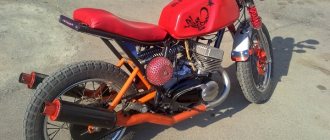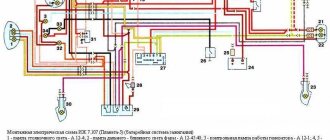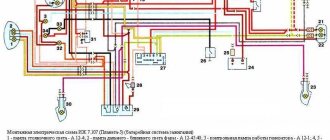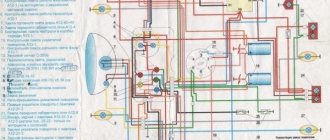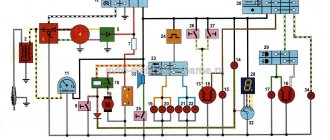The first models of motorcycles of the JAWA family required improvements, which the Czech manufacturer successfully carried out throughout all the years of production. And if at first Java model number 634 (see wiring diagram) switched to 12-volt equipment experimentally, then model 638 received this configuration as standard.
Factory wiring diagram Java 638 in Czech
Java motorcycle: tuning. Java 350: ways to improve
One of the best ways to modernize a motorcycle is tuning. "Java 350" is no exception. Some owners want to give their equipment sporty characteristics, others take a more practical approach. As a result, the bike becomes faster, lighter and more maneuverable. Let's look at the components that are most often subject to restyling.
Sports modification
The operational parameters of the Czech motorcycle are still relevant today, but the design leaves much to be desired. How to carry out sports tuning? “Java” in this matter is most easily upgraded by installing parts from Kawasaki or Yamaha racing bikes. The fenders will fit from the first model, and the second option is a good donor for brakes, front forks, shock absorbers, pendulum and wheels.
The pendulum element for installation in the socket of the motorcycle in question should be narrowed by replacing the standard bearings with needle pin elements from the Volga. The changes made give the vehicle better controllability, stability and maneuverability. The body kit can be done independently or in a specialized workshop. When doing work at home, you need to be careful and stock up on fiberglass or plastic.
Advantages
Many motorcyclists attribute the excessively light front part to the main disadvantages of the Java. In this regard, to achieve a general reduction in weight, a counterweight is installed at the front. Installation of disc brakes, alloy wheels, and a more wear-resistant chain is also sports tuning. At the same time, the Java 350 acquires characteristics characteristic of motocross motorcycles, namely:
- increase in speed indicator;
- fast acceleration;
- improved handling;
- safety;
- beautiful exterior and convenience.
Sports restyling is the most common type of modernization in relation to a Czech motorcycle, which is due to its technical features.
Engine tuning (Java 350)
First of all, motorcycle owners try to improve the speed parameters of the car. It is worth noting that installing a five-speed gearbox does not always give the expected result. Its installation is justified only in case of modernization of the engine and chassis.
Boosting the power unit ensures an increase in the maximum speed during acceleration. However, there are several nuances here too. Such modification of the engine involves increased fuel consumption and heating of the working parts involved in the starting process. In addition, boring the cylinders helps reduce the thickness of their walls. This leads to increased heat transfer, decreased compression and possible jamming.
Addition
Tuning Java 350 very often affects the exhaust system. Despite contraindications from specialists, many owners install forward flow systems made from VAZ 2131 mufflers on this motorcycle; 21213; 21214. The part of the pipe leading to the engine is cut 5 cm from the muffler itself, and the part going out is bent at the required angle. When connecting to the elbow, the pipe is slightly cut and pressed tightly. The body mount is first welded to the forward flow, and a footrest is finally mounted on the motorcycle itself.
A tachometer will add to the presentation and functionality of the unit. Its connection is made according to the same parameters as in the car. Installing a starter on a Java 350 is a rather complicated procedure, but quite realistic. It requires a flywheel change, additional mounting on the body and a reinforced battery.
Motorcycle lighting is another characteristic manifestation of sports tuning. LEDs, the color of which can either emphasize the color of the device or be in contrast with it, illuminate key design components: the engine, exhaust pipe, rims.
Correctly performed tuning can not only transform your two-wheeled friend, but also significantly improve its technical parameters, making the motorcycle the envy of surrounding motorcyclists.
Java is a dream motorcycle of the 70-80s of the last century. IZH, Voskhod, Minsk, even the powerful Ural, all this is not the same in comparison with the only imported motorcycle widely available to the Soviet motorist - Java. And even though this is not a bike from the decaying, but technically more developed West, but an import from a country party to the Eastern Treaty, Czechoslovakia, at that time, was ahead of the USSR in the quality and technical perfection of the motorcycles produced. Java was perhaps the best thing that a Soviet person could acquire for himself back then, and the motorcycle deservedly became a real legend for several generations.
1970 The Java 350 model is entering the market. A powerful, maneuverable motorcycle with a load capacity of 200 kg, a two-stroke engine, disc brakes, and a fashionable and sporty appearance. Java is completely different from other models available on the market. Soviet motorcycles of that time were not far removed in their technical characteristics and appearance from the German models of the 40s, on the basis of which mass production of domestic motorcycles was launched using equipment exported from Germany. Owning a Java motorcycle was considered prestigious, fashionable, and simply a must for anyone who wanted to keep up with the times.
Java tuning and modification of various parts of the motorcycle
Java motorcycle tuning with your own hands. What can be improved in the Java model. Increasing power and other characteristics of the motorcycle.
The legendary Java 350 motorcycle is the dream of every motorcyclist of the late 20th century. Not a single Soviet motorcycle could compare with the quality of workmanship and smooth running of the Java. The particular popularity of Czechoslovakian technology is still relevant today. Naturally, every owner wants to improve the characteristics of the model, and the topic of today's article is Java tuning. In it we will look at what Java 638 tuning is, how to achieve better performance from the engine and create a modern appearance with your own hands. Let's find out how the Java 634 tuning differs from the 638 model and which is better.
Tuning Java 350 let's start with the engine. Clean the engine thoroughly from dust and oil to prevent dirt from getting into the engine. Having completely disassembled the engine, carry out a complete inspection for wear. It is recommended to immediately replace the bearings with new Japanese ones, since only they can cope with the increased speed and increased power when tuning the engine. Keep in mind that boosting the motor is a serious matter; at least turning, a grinding tool, and preferably a drill to change the purge channels will be required. The factory shape of the channels provides traction at low and medium speeds, which is done in order to save fuel. By slightly boring the cylinder bores a few millimeters in height, you can increase the engine speed and, accordingly, its power. To improve purging, be sure to align the channels of the lower plane of the cylinder with the upper plane of the crankcase; steps and protrusions that will interfere with the flow are not allowed. Also sand down any irregularities in the intake and exhaust ports until they are smooth. Then we move on to tuning Java 638 cylinder heads. To do this, having secured the heads in a lathe using a mandrel, cut them with a cutter by 1.5-2 mm, due to which the combustion chambers will decrease and the compression ratio will increase. If you have a Java 634, tuning the pistons consists of making them lighter; to do this, the jumpers of the lower piston skirt are cut off, and the free space under the piston will ensure the unhindered flow of the fuel mixture. Tuning Java 638 is more preferable because it has aluminum cylinders that can withstand boost much better and effectively remove heat.
Improved appearance and safety
Think about safety first. Standard rims, and even more so drum brakes, are not able to cope with the increased power. It is recommended to install a good disc brake along with replacing spoked rims with alloy wheels. This will not only give a modern look to your bike, but will also significantly improve stability on the track. Accordingly, improved rims from another motorcycle are designed for greater braking force and have normal mounting for the brake disc. Good road tires are also a must.
Replacing headlights and other outdated lighting equipment will appeal to everyone. And the dashboard can be easily transformed by installing LED strip lighting.
The standard steering wheel can be easily replaced with clip-ons or a straight-shaped steering wheel, which will somewhat improve the driver’s aerodynamics due to the inclined seating position. Installing wind deflectors is no longer in fashion, as in Soviet times; they create too much air resistance in front of them. Much preferable is a sports body kit, which, depending on the financial investment, can be picked up from any other motorcycle, but if you really want to make it yourself from fiberglass and epoxy resin. Tuning a Java motorcycle in the photo:
And finally, we want to say that a forced engine requires good 2-stroke oil and timely maintenance. Java tuning is a fascinating activity that requires imagination and direct hands. If you follow the tuning technology, the result will not leave you indifferent
The Czechoslovak legend Java 350, from the very beginning of its production in 1970, immediately attracted the attention of motorcyclists throughout the USSR. The agile and maneuverable unit differed from its counterparts in its high load capacity (up to 200 kg), an improved two-stroke engine, reliable disc brakes and a progressive appearance for that time.
Time does not stand still, and in order for the favorite of generations to keep up with modern models, the owners are ready to resort to the most radical changes in its design.
Types of BSZ
There are two types of BSZ:
— Single-channel (one Hall sensor, two-lobe modulator, one switch, one two-terminal ignition coil operating on two cylinders at once)
— Two-channel (two Hall sensors, one, or better yet two, modulator lobe, two switches, two ignition coils, one for each cylinder)
It is preferable to install a single-channel system, since it will be more stable, because here you do not have to adjust each cylinder (which you have to do at KSZ); here, if the modulator is properly made, then only one cylinder is adjusted. Also, in a single-channel one, fewer wires are used, its parts take up less space, and energy consumption is lower (which is very important for 6-volt generators)
There are many people who like to “get confused” who install a two-channel one, shouting at the same time that this way they can configure it more accurately, etc. I assure you that these are unnecessary hassles, and there will be no accuracy here (why is indicated above)
Spark plug. I said above that spark plugs “live” longer, which begs the question “Why?”
Actually the answer is simple. If you decide to install a single-channel BSZ (or a two-channel one with a two-lobe modulator), then this is what will happen:
When igniting in one cylinder, in the other, a spark will also strike at BDC, since it strikes simultaneously on both spark plugs, that is, spark twice per revolution on each spark plug.
What does this give? This allows for warming up and cleaning of the spark plugs at that moment the pistons are at bottom dead center, we get a smaller temperature difference between the spark plug electrodes (not allowing it to cool) and clean electrodes, ready for the new ignition of the fuel mixture. These factors, as practice has shown, increase the service life of candles.
Maximum current selection
The manufacturer’s official instructions, in addition to the technical regulations, also prescribed recommendations regarding the selection of maximum current from the generator:
- A power of 15A is permissible for selection, provided that the temperature of the stator winding does not exceed 155C;
- With the Java-638 trailed stroller and with all constantly switched on consumers, a long-term connection of one more consumer is allowed, the power of which does not exceed 42W (3A);
For reference: this recommendation applies to a climate zone where the maximum ambient temperature does not exceed 30-40C, and the engine operates at low speeds, preventing the generator from developing full power.
Java 638 wiring: colors and designation of main connections
At higher temperatures, such as when operating a motorcycle in southern latitudes, there is a risk of thermal damage to the stator winding. There is also a high probability that the wiring to Java 638 may suffer insulation damage.
